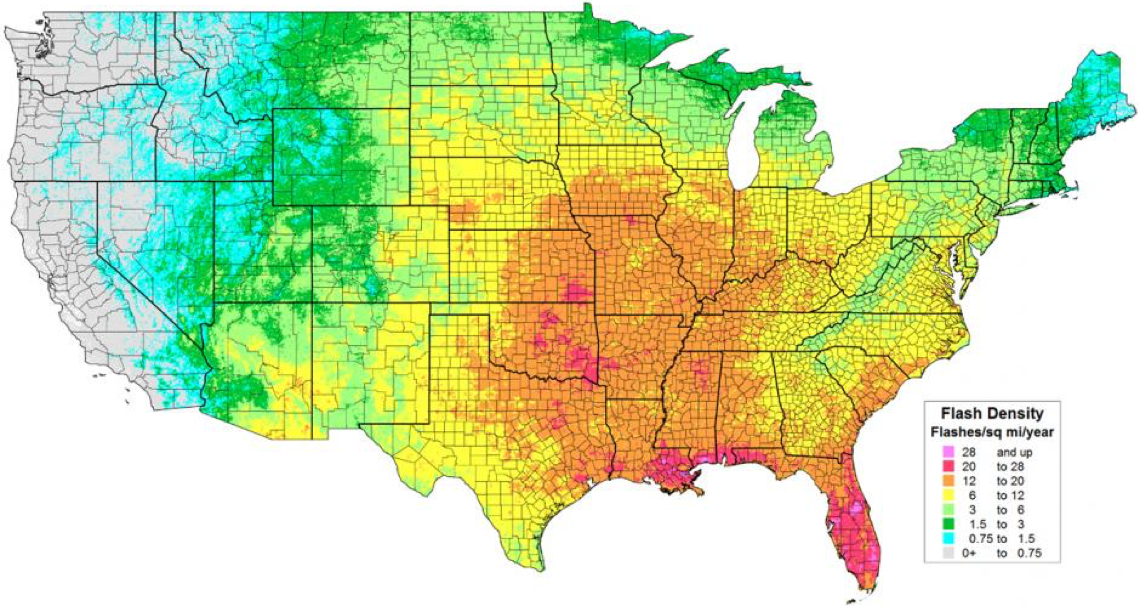Assessing Your Risk
No one can predict when and where lightning will strike. The National Fire Protection Association’s (NFPA) Risk Assessment is the only tool used by the lightning protection industry to determine the risk of a lightning strike. To assess your risk, answer the following questions. Based on your answers, this assessment will evaluate how individual factors, of your structure and its location, affect your need for lightning protection.
-
1Flash Density
-
2Materials
-
3Dimensions
-
4Surrounding Area
-
5Content
-
6Consequence
-
Results

1. What is your area's Flash Density rating?
Select the most appropriate flash density from the list below:
2a. What type of framing is on your structure?
Select the most appropriate material from the list below:
-
 Flammable
ex. Wood
Flammable
ex. Wood
2b. What type of roofing is on your structure?
Select the most appropriate material from the list below:
-
 Flammable
ex. Cedar, redwood, & other wood shingles
Flammable
ex. Cedar, redwood, & other wood shingles

3. What are your structure’s dimensions?
4. Which type of area best describes your structure location?
Select the most appropriate surrounding area from the list below:
-
 Structure located within a space containing structures or trees of the same height.
Structure located within a space containing structures or trees of the same height.
-
 Structure surrounded by smaller structures within a distance of 60 feet.
Structure surrounded by smaller structures within a distance of 60 feet.
-
 Isolated structure, no other structures located within a distance of 60 feet.
Isolated structure, no other structures located within a distance of 60 feet.
-
 Isolated structure on a hilltop.
Isolated structure on a hilltop.
5a. What content value does your structure contain?
Select the most appropiate option from the list below:
-
 Low value and nonflammable
Low value and nonflammable
-
 Standard value and nonflammable
Standard value and nonflammable
-
 High value, moderate flammability
High value, moderate flammability
-
 Exceptional value, flammable, computer/electronics
Exceptional value, flammable, computer/electronics
-
 Exceptional value, irreplaceable cultural items
Exceptional value, irreplaceable cultural items
5b. Is your structure occupied?
Select the most appropiate option from the list below:
-
 Unoccupied
Unoccupied
-
 Normally Occupied
Normally Occupied
-
 Difficult to Evacuate
or risk of panic
Difficult to Evacuate
or risk of panic
6. Which consequence best describes your structure in the case of a lightning strike?
Select the most appropiate option from the list below:
-
 Continuity of facility services not required, no environmental impact
Continuity of facility services not required, no environmental impact
-
 Continuity of facility services required, no environmental impact
Continuity of facility services required, no environmental impact
-
 Consequences to the environment impact
Consequences to the environment impact

A lightning protection system is optional.
We've calculated your results and a lightning protection system is optional. As stated before, this is just a tool used to determine risk. No one can predict when or where lightning can strike. The only way to be truly certain that lightning will not damage your valuable property is to invest in a lightning protection system.
Contact Bonded Lightning Protections Systems, Ltd today for your free quote.
Request Quote
A lightning protection system should be installed.
We've calculated your results and a lightning protection system should be installed.
